|
|
Search for
The Famous Blonger Bros. |
|

August 2006
| 8/1/2006 |
G.I. Joe
Joe served in the 25th Michigan during the Civil War, enlisting in Kalamazoo in 1862. He was just shy of fifteen. H.G. Wells was appointed commandant of his camp. I have no idea if it was that H.G. Wells.
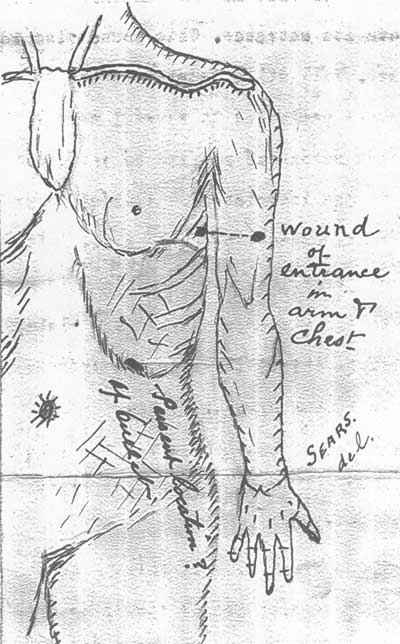
Joe was shot during the siege of Atlanta, the bullet piercing his arm and chest, as seen in this doctor's sketch made in 1912, when the minie ball was located in his chest cavity. The wire services picked up the story:
Bayfield Blade, Sept. 20, 1912
After forty-eight years a bullet has been discovered in the chest of Joseph Blonger of Denver, a veteran of the Civil War.
It's also worth noting that Joe mustered out with his regiment. Following is a partial rundown of the 25th Michigan Infantry in action.
25th Regiment Infantry, organized at Kalamazoo, Mich., and mustered in September 22, 1862.
1862
Action at Bacon Creek, near Munfordsville, December 26, 1862.
1863
Repulse of Wheeler's attack on Kingston November 24.
Action at Mossy Creek, Talbot Station, December 29.
1864
Battle of Resaca May 14-15.
Lost Mountain June 15-17.
Muddy Creek June 17.
Noyes' Creek June 19.
Kolb's Farm June 22.
Assault on Kenesaw June 27.
Nickajack Creek July 2-5.
Battle of Atlanta July 22.
Siege of Atlanta July 22-August 25.
Utoy Creek August 5-7.
Flank movement on Jonesboro August 25-30.
Pursuit of Hood into Alabama October 4-26.
Battle of Franklin November 30.
Battle of Nashville December 15-16.
Pursuit of Hood to the Tennessee River December 17-28.
1865
Capture of Wilmington February 22.
Advance on Goldsboro March 6-21.
Occupation of Goldsboro March 21.
Advance on Raleigh April 10-14.
Occupation of Raleigh April 14.
Surrender of Johnston and his army.
Mustered out June 24, 1865.
Regiment lost during service 1 Officer and 34 Enlisted men killed and mortally wounded and 2 Officers and 141 Enlisted men by disease. Total 178.
Joe made 8th corporal in November of 1864. We have no folklore regarding his service, and don't know specifically where he fought, beyond the battle and siege of Atlanta.
|
| 8/4/2006 |
TRIP REPORT: Philipsburg, Montana
Julie’s family reunion in Whitefish, Montana, was a good enough reason to plan a two-day side trip to Philipsburg to walk the streets that Marvin Blonger, “The Enigma,” once trod. I came with low expectations and, I’m embarrassed to say, little preparation. My goal on Monday, our only full day in town, was to check the courthouse and the historical society and see if I could turn up any evidence of Marvin’s nearly 25-year stay in Granite County, home of some heavy prospecting and mining operations in Marvin’s day.
On the way down from Whitefish we made a stop at the Missoula Cemetery to visit the graves of Mary Blonger, Marvin’s wife, and Edward, his son. Mary died in 1897 at age 45 from the effects of an operation. Edward, who was a miner like his father, died in 1917. Marvin moved around some in the 1890s. His daughter Ollie was born in Montana, perhaps in Missoula, in 1891. But an 1899 newspaper report, after Mary’s death, places Marvin in Park City, Utah. By the time of the 1900 census, Marvin had left Park City and placed Ollie in the care of her older sister Abbie, who had married James Kervin. Marvin headed north with Edward, then 15, to Granite, Montana, up the hill from Philipsburg and site of the heaviest silver mining.
All of this would have been good to know when I arrived in Philipsburg, but because I thought we knew next to nothing about Marvin, I failed to bring any notes with me. Fact is, we knew more than I thought we did.
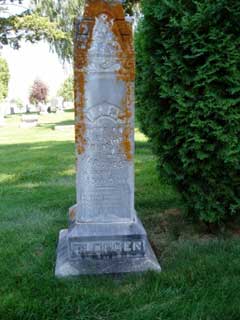 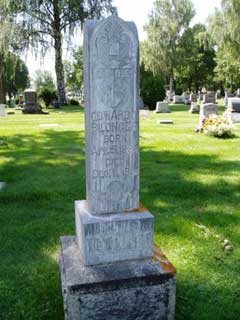
Mary and Edward Blonger’s headstones in Missoula Cemetery.
We pulled into Philipsburg on a bright Sunday afternoon. The town lies on the edge of a three-mile wide valley between the looming Flint Creek Range on the east and the smaller, rolling John Long Mountains on the west. Flint Creek meanders through the meadow in the middle of the valley, but this is no lazy river: the water is moving quickly, dancing its way down to the Clark Fork. Main Street of Philipsburg is wide and welcoming, a little dusty, with many old buildings in various stages of restoration. As we drove toward the center of town, I was immediately struck by the town’s resemblance to Shullsburg, Wisconsin, Marvin’s boyhood home. In both places, the main thoroughfare originates at the highway on the west side of town and climbs to the east. On both sides, the cross-streets rise steeply and buildings on the side streets are easily visible. It’s not a perfect match. Shullsburg has more trees and Phillipsburg is built on the side of a mountain with a terrific vista to the west. But still, as I descended to Main Street, I found myself aching to buy cheese curds at the Shullsburg Cheese Store.
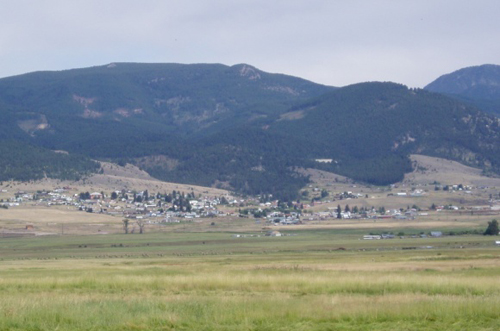
Philipsburg from the northwest. The ghost town of Granite
is on the back side of Franklin Hill to the right.
After an overnight at the Quigley Cottage Bed & Breakfast, we started our search at the courthouse, looking for real estate transactions or mining claims. We already knew of one patent, filed in 1904 by the Auraria Mining Company, on two placers and two lodes about six miles from Phillipsburg. Auraria was the name of Sam and Lou Blonger’s mining company in Colorado, and the fact that a company of the same name filed a patent near where brother Marvin was living and working appeared to be more than just a coincidence.
As it turns out, Marvin was no Donald Trump, but he did buy a plot in the town of Philipsburg. on July 27, 1911, for $650. It’s unclear whether the land already contained a house when he bought it, but it surely did when he sold it on January 23, 1925, for $2,000. With the help of a town plat map, our goal of locating the site proved ridiculously easy: Marvin’s house was thirty feet away, right outside the window of the room we were sitting in. Well, not Marvin’s house exactly. The home on the current site is of recent construction. A walk outside revealed two neighboring homes that seemed to be contemporaries of the Blonger house. Our B&B hosts, Dave and Davee Letford, later confirmed that Marvin’s house was torn down only a couple of years ago and replaced by a new two-story model.
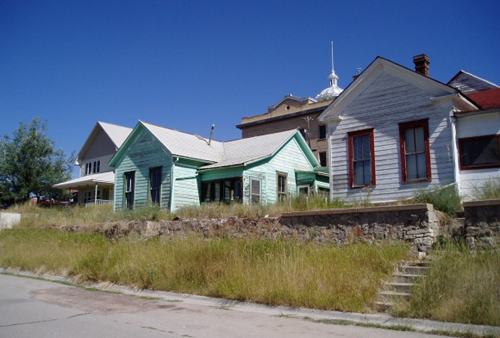
The yellow house at the left now occupies the site of Marvin’s house, which
was
similar in construction to the two houses in the foreground.
-marvin's house closeup.jpg)
A view of the courthouse, circa 1920. Marvin’s home is in the center of the photograph.
Further searches in the courthouse records turned up the Auraria transactions. The claim on the Confident lode was filed on October 7, 1896, by Matt Anderson and John Olson for the Auraria Mining Company. The patent for the four parcels (Confident lode, Julee lode, Castle placer, and Placer No. 1 placer), filed on November 19, 1904, indicates that claims for all four were made on December 31, 1902, but I did not find this document. All four patents were sold at a tax auction in 1913, ending Auraria’s brief history as a Granite County land owner. I found no evidence that the Blongers had anything to do with this Auraria, which was disappointing. The case is still open, but the fact that Lou and Sam Blonger were prominently named on the Colorado patent, and not in Montana, makes me think this could simply be a case of a company with the same name.
While the courthouse rolls revealed that Auraria was a likely red herring, they also dangled an enticing new lead. On August 18, 1909, Marvin Blonger filed a claim on two lodes, the Deer and the Bear, in the Granite district. According to the documents, Marvin had made discovery cuts on both claims. At the courthouse I was unable to find a location map of the claims in the Granite district, but once again our hosts came to the rescue. Davee Letford is a real estate agent who has helped buy and sell many of these claims. Her map showed that the two claims were adjacent parcels at the southern part of the Granite district, in the hollow of Douglas Creek. Marvin held on to these claims until October 4, 1917, when he sold them the Bi-Metallic Mining Company for the sum of $1. Why Marvin never patented the claims and why he turned them over to Bi-Metallic for a song are huge questions that need to be investigated. Bi-Metallic turned around and filed the patents, establishing ownership of the land, on November 1, 1918 (for the Deer) and June 20, 1919 (for the Bear). Both parcels are currently owned by a company called Cottage, Inc.
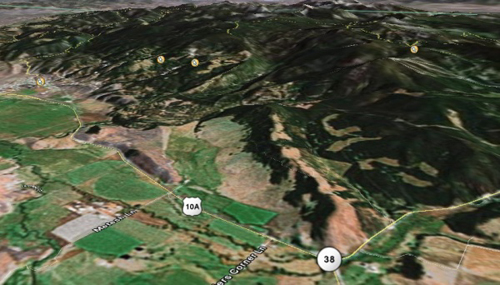
Aerial view of Philipsburg area, looking northeast. The pushpins represent, from left to right: (1) Marvin’s house in Philipsburg, (2) Granite town site on Franklin Hill, (3) Marvin Blonger’s claims along Douglas Creek, (4) Auraria Mining Company’s claims along the North Fork of Flint Creek. (Image from Google Earth)
It was time to search for Marvin’s land. Our trip to the ghost town of Granite was a bumpy ride up a narrow, rutted, dusty road that hugged the south side of Franklin Hill. At certain points, the canopy of pine trees broke away to reveal a dizzying view of the valley below. Near the top of the mountain we began to see remnants of the town that once held 3,000 miners. Marvin lived here in 1900 and 1910, perhaps until he bought his plot in Phillipsburg in 1911. Now all that is left are scores of dilapidated structures, mostly reduced to piles of rotting lumber, along with some more modern structures that indicated some minimal mining was probably still taking place. Marvin’s claims, the Bear and the Deer, were about a half a mile down the hill from the Granite town site, perhaps 400 feet lower in elevation. There was no time for a hike through the forest and brush, but I was able to get a sense of what the land was like and what Marvin must have gone through to establish his claim. No doubt it was tough getting to and from his land and digging in the rocky earth. On a return trip I might be tempted to reach the claim by ascending along Douglas Creek rather than tracking down from the Granite town site. I suspect we will be able to find evidence of mining operations, perhaps including the discovery cuts that were shown on the mining plat map.
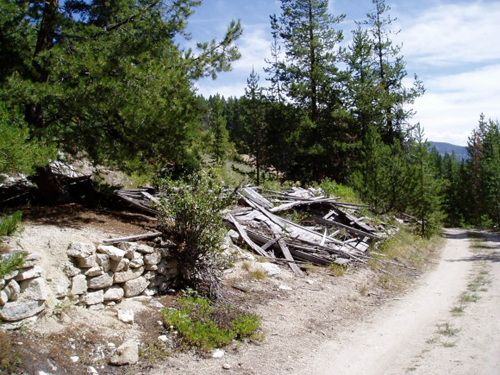
Ruins in the ghost town of Granite, Montana.
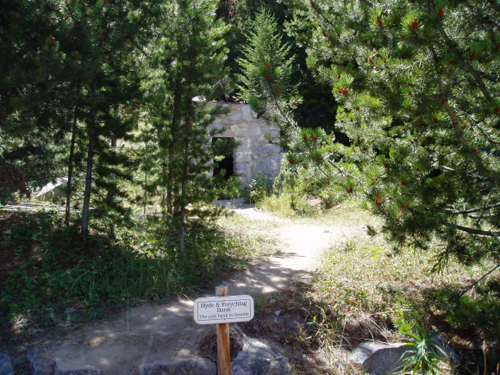
The old bank vault is one of many crumbled relics in Granite.
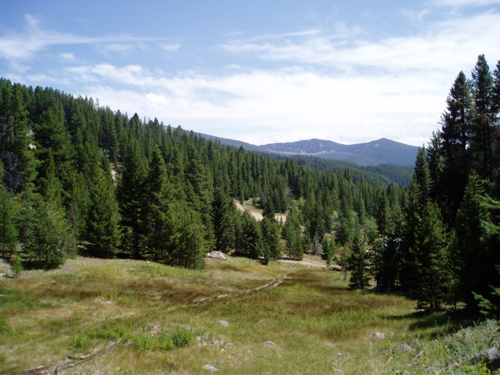
Looking toward Marvin’s claims, a half-mile out and some 400 feet below this spot.
I set out on my own to find the Auraria claims on the North Fork of Flint Creek. Though only about four miles away by air, reaching the site by car required a circuitous trip of about 25 miles up into the hills past Georgetown Lake and the Discovery Ski Resort. A right turn near the resort put me on an arrow-straight gravel road that ascended slowly but surely through a forest of lodgepole pine. Through the topographic map showed the creek paralleling the road, the stand of trees effectively hid the water and the ridges that rose on either side. Not until I reached my destination, about four miles up the road, did the forest yield to the rest of the scenery. There, a road broke off to the left, down a small hill, over a culvert containing the small creek, and into an excavated area. A sign warned that blasting was taking place here. The operation was actually a little beyond where the Auraria claims were located, but as far as I could tell, the Auraria land was simply rocky forest ground. I did not investigate Red Lion, a small ghost town a little further down the road.
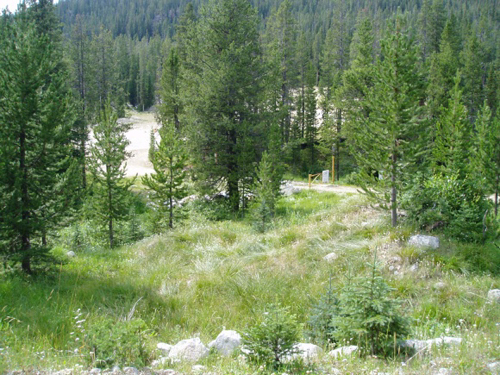
Active mining operation near the site of the Auraria claims.
The creek crosses the road in a culvert near the gate.
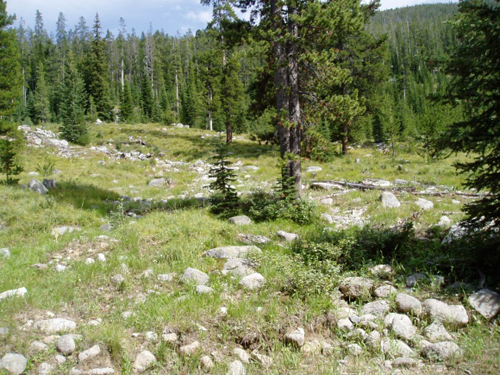
The rocky ground of the Auraria claims.
Back at the Quigley B&B, we recounted our experiences. Dave Letford had promised to ask an old-timer about Marvin Blonger, but I didn’t expect any useful information. According to his obituary in 1927, Marvin left Philipsburg about three years before his death to live with his daughters, first in San Francisco and later in Dunsmuir, California. That anyone still living would remember a man who left town 80-some years ago was really too much to hope for. But in small towns people have long memories, and it seems the Blonger name made an impression wherever it happened to appear. Dave asked if I wanted to see where Marvin worked, so we took a ride in his ATV to the edge of town to the ruins of the Philipsburg Mining Company, where the old-timer, Roy, remembered that Marvin was the superintendent. That seemed a possible fit with the census records, which showed that in 1900 Marvin was a “boss in mine” and in 1920 was a foreman in a silver mine. By 1920 Marvin was 69 years old, ancient for a miner, a little old to be named superintendent, but then, who was to say?
As we inspected the broken foundation and timbers, Dave hit me with a surprise. Roy hadn’t wanted him to mention this at first, but the rumor was that when the Philipsburg Mining Company burned down in the 1920s, Marvin lit the match.
Well, I thought, even if it isn’t true, at least Marvin now had an identity. “The Enigma” has become “the (Reputed) Firebug.”
A little research back home revealed that the plant burned down on February 19, 1925, putting the company out of business. Marvin had sold his house four weeks before. Did he leave immediately for California, or did he stick around long enough to lay the torch to his former workplace? Would a 74-year-old man, perhaps in ill health, soon to leave town, really turn to arson to settle an old score? Or could it have been the notoriety of the Blonger name, given Lou’s recent arrest, trial, and death, that caused townspeople to suspect Marvin? Perhaps it was just a whisper campaign against a convenient target, an old man and a harsh boss, who happened to pick the wrong moment to move to another state.
Or perhaps, there’s no smoke at all. Here’s what Clyde J. Neu had to say about the fire in A Town Founded on Hope (1996):
In 1921 Ralph S. Blitz was named Superintendent of the Philipsburg Mining Company…. Annually the company suspended operations for about two weeks in January to overhaul and repair the mill. During this closure in 1925, the mill caught fire and was completely destroyed. There was much speculation in town as to whether the fire was intended or an accident. In any event its burning spelled finis to the company’s operations, as they never rebuild the mill. All operations for the present ceased and Blitz left the company on May 22, 1925.
Roy, our informant, had mentioned that Marvin Blonger was the superintendent of the mill. Could he have been remembering Ralph Blitz instead? Blonger…Blitz? Odd-sounding names starting with BL? Whatever the case, Marvin went to California a free man and died there less than three years later. Answers to the mystery may await us in microfilmed copies of the Philipsburg newspaper.
In summary, our brief trip to Philipsburg was interesting and definitely worth a return someday. The Letfords were very knowledgeable about local history and, thankfully, more than willing to help our search. And for a town of 1,000 people nestled in a county of 2,800, Philipsburg offers far more than expected. It is full of historic buildings, including the state’s oldest still-operating jail, school, and theater, all built in 1896. Julie’s a theater buff, so we rolled into town just in time for the Sunday evening performance. That was fun, too, except for the vamp routine where I was corralled onstage with a feather boa around my neck. But that’s Blongermania – a surprise around every bend.
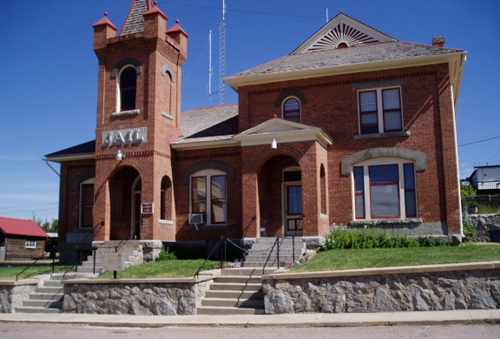
Granite County Jail.
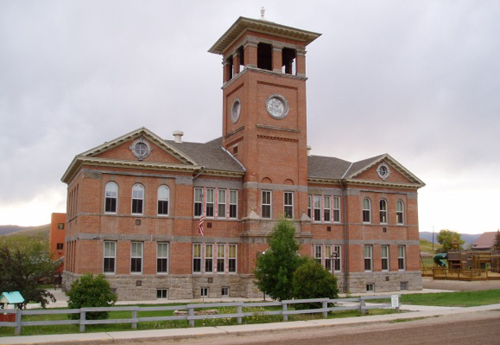
Philipsburg Grade School, originally a high school.
The "Prospector" logo is painted on the tower window.
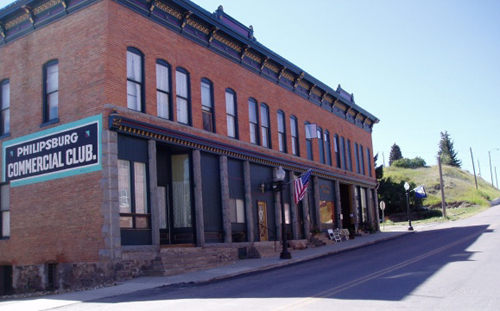
Opera House Theatre.
There are more photos of Philipsburg, modern and historic, available at Western Mining History.
—SJ
|
| 8/5/2006 |
Line of Succession
To quote Alexander Haig: "I'm in control here..."
Craig's out of town so I've taken over the blog for a couple of days. And in somewhat of a surprise in a generally slow summer (we've both succumbed to real-world duties), I actually have news to report.
In doing a routine follow-up of the Bureau of Land Management's partially implemented Land Patent search, I decided to scan for "Blouger," a common mistranscription of "Blonger," and turned up a previously undiscovered patent granted to Sam Blonger and one Bartholomew Coughlin on a claim outside of Leadville. We've never had the opportunity to investigate claims and patents in Leadville, where four of the Blonger brothers -- Lou, Sam, Simon, and Marvin -- briefly shared residence in the early 1880s. While Sam and Lou soon moved on to Albuquerque, Simon stayed behind as the superintendent of the Robert E. Lee mine. Marvin, the youngest of the brothers, also remained in Leadville for several years.
We've always suspected that the Blongers owned a mine in Leadville. In fact, there is a mine so named: the Blonger Mine, still listed as mindat.org. Jack Davidson found references to the Blonger Mine in the Denver Public Library. Meanwhile the encyclopedic History of Leadville and Lake County, Colorado indicated that there was a "Blonger lease" on the New Pittsburg or Big Pittsburg Mine, and we've never been able to determine whether this lease and the Blonger Mine were the same thing or something completely different.
The newly discovered patent is for the Hibernian (or Hibernia) Mine, right in the middle of all the activity of Fryer Hill, where the biggest strikes were made. In fact, it could easily be the Blonger Mine. The general location of the Hibernian (parts of Sections 19 and 24) given in the patent index, is consistent with the coordinates of the Blonger given in mindat.org, but more information is needed.
Even more interesting, if that is possible, is the date of the patent: April 15, 1882. Sound familiar? Sam and Lou were already in Albuquerque, serving as marshals and of course entertaining other business opportunities along the way. Meanwhile, Wyatt Earp and his posse were making their way out of Arizona to the relative safety of New Mexico. The Earps supposedly landed in Albuquerque on April 15 or 16 and, if the Otero Letter is to be believed, were soon under the care of "Blonger" -- some Blonger, either Sam or Lou.
Sam was in Albuquerque on the date the patent was granted. But both of the town's newspapers reported that Sam left for business in Denver on April 18. The Albuquerque Evening Review went further:
Marshal Sam Blonger goes to Denver to-morrow with samples of ore and maps of the Star mine in Hell canon. The Star now shows an eighteen foot vein of pay ore between walls, and the samples from it which Blonger will carry with him doubtless attract great attention in Denver.
Was Sam on his way to sell a mine, or to take care of his own mining business in Leadville? One thing is certain. He wasn't looking after Wyatt and the boys.
—SJ
|
| 8/5/2006 |
Sam and Joe's Gold Mines -- Figurative, if not Literal
Several online sites list coordinates for the Hibernia Mine. It's about a quarter mile north of the location given for the Blonger Mine. The Hibernia appears to be at the bottom of Fryer Hill, near the road (E. 7th St.). One site with a series of old biographies mentions a man named Franklin T. Caley who bought a one-sixth interest in the Hibernia for $5,000 and cleared $50,000. If Sam played his cards right, he made a lot of money from the Hibernia.
A couple of years earlier, Joe was down in the Cerrillos Hills making the same kind of transactions. Information that Bill Baxter compiled and presented to us on our journey to New Mexico last year shows that Joe and his partner C. M. Purdin were very active in locating claims and dealing them in 1879 and 1880, at the start of the boom in the Hills. Blonger & Purdin located three claims -- the Agricultural, Purdin, and Vulture -- in August and September, 1879, and sold them as a package deal in December for $5,000. They sold a four-sixths interest in another mine, the Washington, for $5,000. And their original mine, the Union, packaged with a portion of the Independence, sold for $4,900.
As they say, that was a lot of money in those days.
For a magnificent overview of the Cerrillos Days, with historic photographs of the miners and their mines, check out cerrilloshills.org.
Meanwhile, we need someone to take a field trip to Leadville. Any takers?
—SJ
More Fun With Google Earth
I should have done this a long time ago.
I plotted out where Joe Blonger's claims were in the Cerrillos Hills, compared with where Bill Baxter walked us around last year. We walked in a rough triangle between the three spots on the left. Joe's claims are in the foreground, in Hungry Gulch. We would've needed a lot more water to get there and even then I think we might have had to drag Craig by the feet.
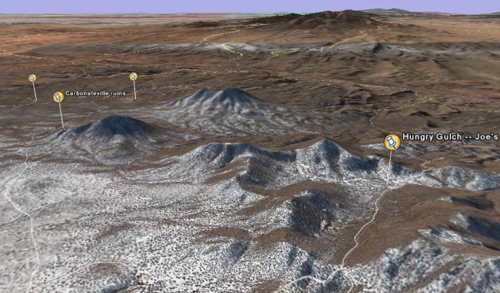
—SJ
|
| 8/7/2006 |
Enigma, Schmenigma
Drug by the feet indeed. Just bury me on the lone prairie.
I, by the way, would like to vote on Marvin's new alias. I like Marvin "The Torch" Blonger, myself.
-CJ
|
| 8/11/2006 |
Ed Blonger and Ruth Hickey
We've mined the Internet for Blonger references pretty thoroughly, but new items always turn up. I search newspaperarchive.com and other historic newspaper sites fairly regularly. Their coverage includes a lot of small newspapers and many larger ones from the kind of towns the Blongers frequented. Three new clippings showed up today that each provide a brief glimpse of our Blongers at work.
Anaconda (Mont.) Standard, Feb. 16, 1912
Philipsburg, Feb.14 — Miss Ruth Hickey left this morning for Butte, where she will marry Ed Blonger, formerly of this place. The young couple will leave immediately for California to spend the winter.
Alas, this was a tragic union. Ruth died on Sept. 1, 1916, back in Granite County. According to one online genealogical file, which must be taken with a grain of salt, she committed suicide because she thought she was pregnant, when she actually was not (how would they have known?). Marvin's son Ed died Dec. 11, 1917, and is buried in Missoula Cemetery, which we just visited.
-SJ
Joe and Carrie Viles
Santa Fe New Mexican, July 31, 1951
What's that you say? All the Blongers were dead by 1933? Just hold on.
Santa Fe New Mexican, July 31, 1951
50 Years Ago.
R. Gibson and Joseph R. Blonger made a trip today to the mountains northeast of the city to look at several mining prospects.
Very interesting. Joe's wife Carrie Winsor Viles lived in the mountains northeast of Santa Fe, in a mining camp named Macho. They were married in Santa Fe April 10, 1902. Could they have met on this trip?
-SJ
A Day at the Races
Ogden Evening Standard, Sept. 22, 1910
EVERYTHING IN READINESS FOR RACE MEET OPENING
List of Owners and Horses.
Deeming that it would prove of interest to the racing public the Standard has compiled the full list of owners who have horses at the track together with the names of their horses, the same being herewith appended:
Blonger and Millsap, John H. Snowball — Silver Stocking, Overon, Jupiter.
No surprise here. A Blonger was running horses, and my bet is it was Sam.
-SJ
The Queen
And then there was this one from findarticles.com, which indexes modern newspapers.
Colorado Springs Gazette, July 31, 2003
75 years ago:
What is reported to be the richest strike made in the Cripple Creek district in recent years is said to have occurred in the Forest Queen, the famous Bull Hill mine of the late Lou Blonger of Denver, and now controlled by the Blonger estate, concerning which it is said a quarter interest was once given for a case of whiskey, and in the W.P.H. of the United Gold Mines, adjoining. It is said the ore is running $40 a ton, mine run product.
The Forest Queen was a steady producer in the 1900s and 1910s, making Lou and Sam rich men. Looks like his widow Nola did okay too. We've never heard the story about the case of whiskey before… Craig, do you have a story brewing?
-SJ
More on Da Big FQ
So Nola still had the mine in 1928? Interesting.
On the other hand, there's the four-foot vein discovered, apparently, a day or two after Lou's conviction in 1923:
Atlanta Constitution, March 31, 1923
GOLD DISCOVERED AT CRIPPLE CEEK
Convicted Con-Man Holds Interest in Mine, It Is Found.
Denver, Colo., March 30.—Gold, in a vein four feet in width and said by mining men to represent a value of thousands of dollars, has been struck in the Forest Queen mine at Cripple Creek, Colo., in which Lou Blonger, convicted leader of Denver's alleged nation-wide confidence ring, holds an ownership interest, it was revealed definitely here today.
The information was received just two days after Blonger, who is 72 years old, was lodged in the Denver county jail following his conviction with the 19 other members of the alleged ring.
Gold was struck in the mine which is held under lease by Edward Gaylord, of Denver, while workmen were boring through from the W.P.H. mine to the Forest Queen to establish an air connection.
Now that had to hurt.
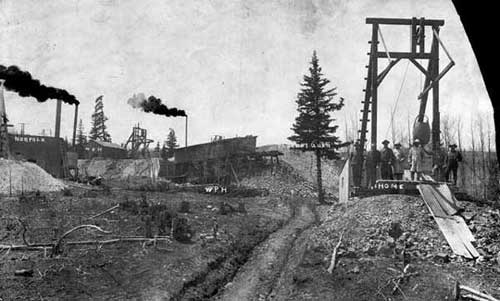
Here the W.P.H. is center, and the Forest Queen is center left in the distance.
-CJ
More on Da Ponies
And John H. Snowball? Cool. At first I thought he was a horse.
Sam seemed to be the real horseman of the two. A small sampling of his stable, to our knowledge:
- Silver Stocking
- Sorrel Dan
- King Lyon
- Comanche Boy
From Lou's obit:
A number of years ago Blonger tried his hand at the horse racing game, maintaining a fine stable.
He owned several fine ranches near Denver, but had disposed of all of them except the Bee Hive farm on the Golden road, one of the best improved ranches in this region.
We should find out which ranches. Maybe the current owners, if any, would like to know. Or maybe there's something they can tell us...
-CJ
|
| 8/12/2006 |
I Dream of Blonger
Mom had a dream a few nights ago. We were in that cabin in the mountains I never built after high school, burying treasure under debris on the floor. Men in cowboy hats, surely the Blonger boys, were there, outside. She noticed Scott wasn't with us, and asked me about it. "Don't worry," I replied, "he says everything will be okay."
-CJ
Joe Furey
Furey led a gang of con men around 1920. They worked all over — Lou's Denver, Texas, Florida. Finally they shore the wrong sheep, one Frank Norfleet, a diminutive Texan who could hold a grudge. And why not; they managed to sheer him twice, for a total of $45,000.
But Frank didn't know when he was licked, and embarked on a cross-country manhunt for every last member of the gang. And he succeeded. Finding Furey in California, he turned him over to the police, but he bribed his way out before Norfleet had finished the paperwork. The chief of police and the whole bunko squad resigned. Norfleet caught up with Furey in Florida, and had him extradited to Texas where he was given twenty years.
In 1921, Denver DA Van Cise met Doctor W.H. Scherrer, a Texan, from whom the Denver gang had taken $25,000 in a fake horse race. One of those involved was named Goodrich, famously the only man of the Blonger operation ever to serve hard time, so the cops had a mugshot.
Scherrer had heard about Furey, and gone to see him in the pen. According to Van Cise, Furey said to Doc Scherrer:
"I used to work in Denver. You go there and see the 'Boss'. He gets fifty-five percent of the swag, and if you put the pressure on right, I think you'll get your money." That is to say — under the right conditions, a con man or his 'Boss' might give back some of your money, if a refund is the expedient thing to do.
"But who is the 'Boss'?"
"I won't tell you that, but if you scout around Denver a little while you will learn his name. Ask anybody in Denver that knows anything at all. Why, just step up to the clerk at the Albany and ask him who the 'Boss' is and he'll tell you. I know your man Goddrich, also, but you get him through the 'Boss'."
Scherrer then went to Denver, hired then-Denver DA Charley Fox as his lawyer, and set about negotiations with Lou for a settlement. But Fox was no help, and probably was paid to be that way.
Sherrer then hired Pinkerton G.A. Fuller, who got better results. First Lou offered two thousand for the agent to blow-off Scherrer. Then ten thousand to settle, but only if Goddrich paid the same. Goodrich had gone to the pen in 1912 when he refused a similar arrangement, and he did so again, leaving Colorado for good. Scherrer eventually gave up.
Blonger gang member Walter Byland hinted at the darker side of these charming swindlers when he said, of Norfleet, when Byland's crew started working on Norfleet in Florida: "We thought Frank was a real boob, but Joe Furey, the man Norfleet was after, was sitting on the piazza of one of the hotels as we went by, and recognized him. He sent us a note, stating that the chump was Norfleet, and to grab him, tie him up with baling wire, rap him over the head, and throw him in the lake during the night. We intended to do it, but Norfleet beat us to it and got away."
All this is in preface to say we heard from a woman the other day who believes her husband's grandmother may have been the child of Furey. Among other evidence, she said they have a bed with "Furey" carved into a slat. Cool.
-CJ
|
| 8/13/2006 |
The Saloons (we know about)
- 1870s, Salt Lake City, supposed gambling/showboat on Salt Lake
In the early '70s, Lou and Sam built and ran the first steamboat that ever plied on the Great Salt lake in Utah. Dancing was among the entertainment features on the boat. The venture lost them money.
- 1874, Salt Lake City, Omaha Beer Saloon
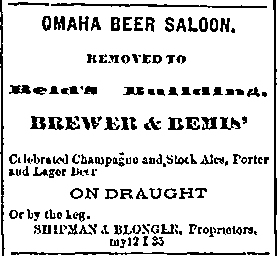
- 1876, Cornucopia, NV, The Palace
In the first place, I mention one grand event, that is the arrival of Hon. J. O. Ivory Esq. and Mr. Robert Hubbs, of the committee to locate the Owyhee bridge, veni vidi vici. The bridge is located at a feasible point on the Owyhee, below Power's place, a good site. All are now anxious that the works of the committee will meet its fruition and reward. When the honorable committee left us the Judge had two babies in his possession, which he had donated to him by Sam and Lew Blonger of The Palace. Adious, Judge; God bless you.
- 1877, Tuscarora, NV, The Palace
- 1879, Georgetown, CO, Novelty Theatre
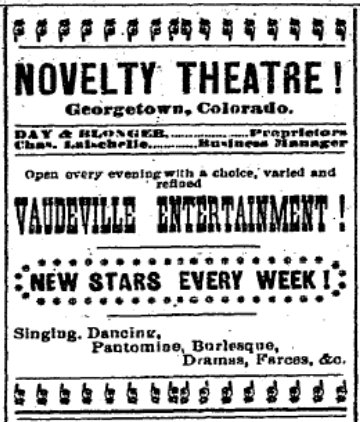
- 1890?, Denver, The Elite, Stout between 16th & 17th
The Blongers in the '90s opened and for years operated the Elite saloon, adjoining the Equitable building on Stout street near seventeenth, the finest bar in Denver at the time.
- 1892, Denver, The Tourists Club, 1740 Larimer
Tolly had
complained to the police that he had come to Denver and had been discussing
a money transaction with a friend in the Markham hotel, when two men, who
had been listening, approached him and began talking of mining. On the
pretense of showing him some ore from Creede, they invited Tolly to walk
with them to Larimer Street. As they passed the Tourists club, the story
goes, one of the men asked Tolly if he would mind stepping in for a few
minutes. Tolly stood behind one of the men as they engaged with a some
others in a friendly game of poker. One of the men drew three aces and a
king and turning to Tolly asked him what he would bet on it. Tolly
reluctantly replied that if he were playing he would put $100 on it. The man
on the other side of the table made a pretense of taking the bet. Of course,
the aces and the king lost. The men then insisted that he pay, and when
Tolly attempted to escape they threatened his life if he did not sign over
the money. Tolly made out a check for $100 and went back to Longmont.
Friends urged him to return to Denver and complain to the police. His
complaint resulted in the raid.
- 1895, Denver, Lew Blonger's saloon, Croff & Curtis Bldg, 1644 Larimer street
The fight on Market street seemed to arouse the fighting blood in the veins of the two Smiths, and instead of doing as they promised to they proceeded to terrorize Larimer street. In Lew Blonger's saloon, 1644 Larimer street, they attempted to pick a fight with some gamblers, but Officer Kimmel heard the loud talking and entered the saloon and ordered the Smiths out. Next they went into the big Arcade saloon, and there they made an attack on Charlie Lord and struck him over the head. John Hughes interfered and tried to make peace. Bascom Smith then made an unprovoked attack upon him, and struck him with his gun, cutting his nose. Officer Kimmel heard of the row, but when he appeared the row was over and he was assured that nothing had happened. The bartender afterward explained that he was afraid to give the Smiths away, as he greatly valued his head.
There were more, we know, but have no specifics. They were also known to have policy shops, and probably gambling houses.
-CJ
|
| 8/15/2006 |
Anchors Aweigh!
The Galveston Daily News gives us a rare glimpse at the personal lives of the Blongers.
On January 13, 1909, the News noted that Mr. & Mrs. S. H. Blonger of Denver had checked into one of the local hotels. The next day's issue reported that the couple, along with Nola Blonger (Lou's estranged wife) was among the “cabin passengers” on the steamship Denver, bound for New York.
Listed along with the Blongers in the steamship notice was Miss Clara Lieberman of Denver, presumably Nola Blonger's travel partner. The previous day's hotel report lists a Mrs. G. A. Lieberman of Denver, probably the same person. These clues send us off to search the 1910 census, and sure enough we find Clara Lieberman of Denver, age 40, wife of Gus Lieberman, candy maker.
We'll likely never know any more details of this trip, but it does paint an interesting picture. Sam may have been unlucky with his first two wives (plus at least one would-be wife who sued for breach of promise), but at age 70 he was sufficiently happy to accompany Virginia and Nola and her friend on a weeks-long cruise.
In case you're wondering about the S.S. Denver, I found some information on the ship at http://archiver.rootsweb.com/th/read/TheShipsList/2000-04/0956170440
DENVER
Call sign: KFRN
Official Number: 157628
Master: Captain S. Risk, appointed to the Shipping Line in 1878 and to the vessel in 1901
Rigging: steel single screw Schooner; 2 steel decks sheathed in wood & partial steel Awning Deck sheathed in wood; web frames; 7 cemented bulkheads; fitted with electric light; water ballast, Forward Peak Tank 35 tons; Aft Peak Tank 9 tons
Tonnage: 4,549 tons gross, 3,167 under deck and 2,819 net
Dimensions: 372.7 feet long, 48.2 foot beam and holds 24.5 feet deep; Poop 84 feet long; Bridge Deck 158 feet; Forecastle 91
Construction: 1901, Harlan & Hollingsworth Co. in Wilmington, DE
Propulsion: triple expansion engine with 3 cylinders of 33 1/2, 54 & 87 inches diameter respectively; stroke 54 inches; operating at 180 p.s.i.; 4 single ended boilers; 16 corrugated furnaces; grate surface 293 sq. ft.; heating surface 12,984 sq. ft.; engine built by the same company as the hull
Owners: New York & Texas Steam Ship Co. (C.H. Mallory, manager)
Port of registry: New York
--SJ
Would you want to sail with Captain Risk?
--CJ
|
| 8/16/2006 |
BlongerWorld
The future meets the past. Powered by Google Maps, we've built an interactive map containing all points Blonger — most anyway, with more detail to come. Mines, saloons, and other locations of interest. Zoom in close enough to see Soapy working the shell game on a Denver street corner. Great tool. Check it out.
BlongerWorld Map of the United States
|
| 8/18/2006 |
The Elite
I'm missing something somewhere. The story is that Sam and Lou had a saloon at 1644 Larimer in the early Eighties, then the Elite a few years later, about 1888-90, we surmised, when they returned to Denver for good.
But news accounts put them at 1644 Larimer — "Lew Blonger's place" — in 1895. This tells us nothing at all about their earliest time in Denver, around 1880, and the late Eighties. They had the Tourists Club in '92. Did the Elite not come along till, say, the late-Nineties? Still no direct evidence of the Elite, but it's a common component of their folklore.
-CJ
|
August 2006
|
Genealogy - History - Gang - Posse - Evening Review
The Grafters Club - Blonger Bros. Fake Restaurant
|
Copyright Notice: Original material copyright 2003-2021 Scott Johnson and Craig Johnson. Other copyrights may apply to materials found herein. Our primary goal is to reintroduce the Blonger Bros. to the lexicon of the Wild West. We therefore encourage the use of our research, provided due credit is given.
https://www.blongerbros.com
|
|



